Xianpeng Lang
The Better You Learn, The Smarter You Prune: Towards Efficient Vision-language-action Models via Differentiable Token Pruning
Sep 16, 2025Abstract:We present LightVLA, a simple yet effective differentiable token pruning framework for vision-language-action (VLA) models. While VLA models have shown impressive capability in executing real-world robotic tasks, their deployment on resource-constrained platforms is often bottlenecked by the heavy attention-based computation over large sets of visual tokens. LightVLA addresses this challenge through adaptive, performance-driven pruning of visual tokens: It generates dynamic queries to evaluate visual token importance, and adopts Gumbel softmax to enable differentiable token selection. Through fine-tuning, LightVLA learns to preserve the most informative visual tokens while pruning tokens which do not contribute to task execution, thereby improving efficiency and performance simultaneously. Notably, LightVLA requires no heuristic magic numbers and introduces no additional trainable parameters, making it compatible with modern inference frameworks. Experimental results demonstrate that LightVLA outperforms different VLA models and existing token pruning methods across diverse tasks on the LIBERO benchmark, achieving higher success rates with substantially reduced computational overhead. Specifically, LightVLA reduces FLOPs and latency by 59.1% and 38.2% respectively, with a 2.9% improvement in task success rate. Meanwhile, we also investigate the learnable query-based token pruning method LightVLA* with additional trainable parameters, which also achieves satisfactory performance. Our work reveals that as VLA pursues optimal performance, LightVLA spontaneously learns to prune tokens from a performance-driven perspective. To the best of our knowledge, LightVLA is the first work to apply adaptive visual token pruning to VLA tasks with the collateral goals of efficiency and performance, marking a significant step toward more efficient, powerful and practical real-time robotic systems.
DriveAgent-R1: Advancing VLM-based Autonomous Driving with Hybrid Thinking and Active Perception
Jul 28, 2025Abstract:Vision-Language Models (VLMs) are advancing autonomous driving, yet their potential is constrained by myopic decision-making and passive perception, limiting reliability in complex environments. We introduce DriveAgent-R1 to tackle these challenges in long-horizon, high-level behavioral decision-making. DriveAgent-R1 features two core innovations: a Hybrid-Thinking framework that adaptively switches between efficient text-based and in-depth tool-based reasoning, and an Active Perception mechanism with a vision toolkit to proactively resolve uncertainties, thereby balancing decision-making efficiency and reliability. The agent is trained using a novel, three-stage progressive reinforcement learning strategy designed to master these hybrid capabilities. Extensive experiments demonstrate that DriveAgent-R1 achieves state-of-the-art performance, outperforming even leading proprietary large multimodal models, such as Claude Sonnet 4. Ablation studies validate our approach and confirm that the agent's decisions are robustly grounded in actively perceived visual evidence, paving a path toward safer and more intelligent autonomous systems.
DriveAction: A Benchmark for Exploring Human-like Driving Decisions in VLA Models
Jun 06, 2025Abstract:Vision-Language-Action (VLA) models have advanced autonomous driving, but existing benchmarks still lack scenario diversity, reliable action-level annotation, and evaluation protocols aligned with human preferences. To address these limitations, we introduce DriveAction, the first action-driven benchmark specifically designed for VLA models, comprising 16,185 QA pairs generated from 2,610 driving scenarios. DriveAction leverages real-world driving data proactively collected by users of production-level autonomous vehicles to ensure broad and representative scenario coverage, offers high-level discrete action labels collected directly from users' actual driving operations, and implements an action-rooted tree-structured evaluation framework that explicitly links vision, language, and action tasks, supporting both comprehensive and task-specific assessment. Our experiments demonstrate that state-of-the-art vision-language models (VLMs) require both vision and language guidance for accurate action prediction: on average, accuracy drops by 3.3% without vision input, by 4.1% without language input, and by 8.0% without either. Our evaluation supports precise identification of model bottlenecks with robust and consistent results, thus providing new insights and a rigorous foundation for advancing human-like decisions in autonomous driving.
TokenFLEX: Unified VLM Training for Flexible Visual Tokens Inference
Apr 04, 2025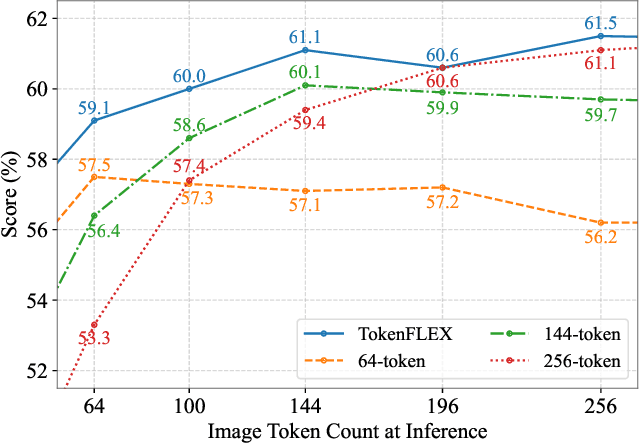
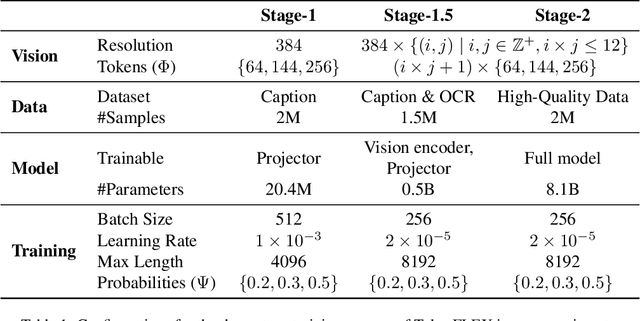
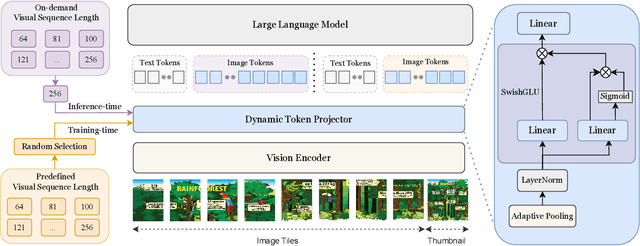
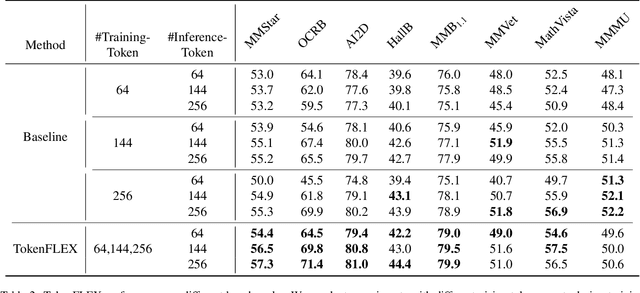
Abstract:Conventional Vision-Language Models(VLMs) typically utilize a fixed number of vision tokens, regardless of task complexity. This one-size-fits-all strategy introduces notable inefficiencies: using excessive tokens leads to unnecessary computational overhead in simpler tasks, whereas insufficient tokens compromise fine-grained visual comprehension in more complex contexts. To overcome these limitations, we present TokenFLEX, an innovative and adaptable vision-language framework that encodes images into a variable number of tokens for efficient integration with a Large Language Model (LLM). Our approach is underpinned by two pivotal innovations. Firstly, we present a novel training paradigm that enhances performance across varying numbers of vision tokens by stochastically modulating token counts during training. Secondly, we design a lightweight vision token projector incorporating an adaptive pooling layer and SwiGLU, allowing for flexible downsampling of vision tokens and adaptive selection of features tailored to specific token counts. Comprehensive experiments reveal that TokenFLEX consistently outperforms its fixed-token counterparts, achieving notable performance gains across various token counts enhancements of 1.6%, 1.0%, and 0.4% with 64, 144, and 256 tokens, respectively averaged over eight vision-language benchmarks. These results underscore TokenFLEX's remarkable flexibility while maintaining high-performance vision-language understanding.
StyledStreets: Multi-style Street Simulator with Spatial and Temporal Consistency
Mar 27, 2025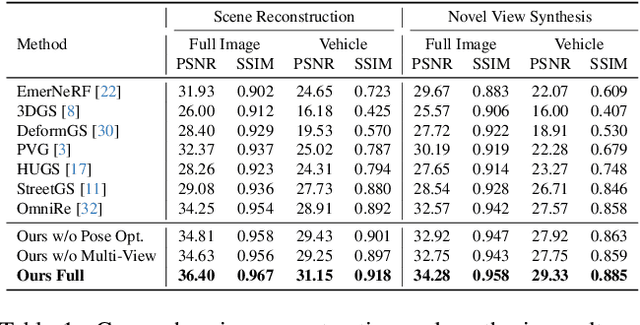
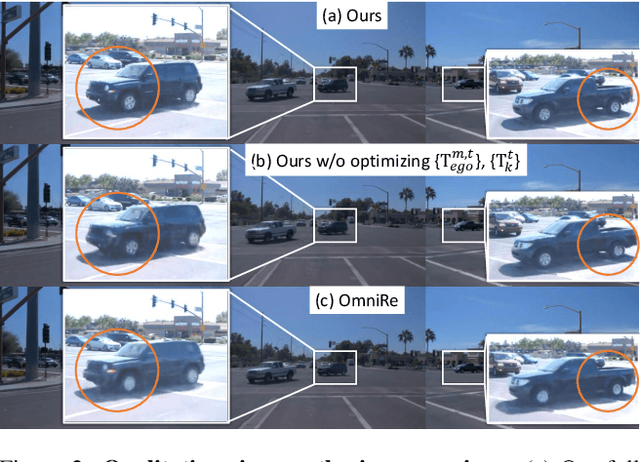
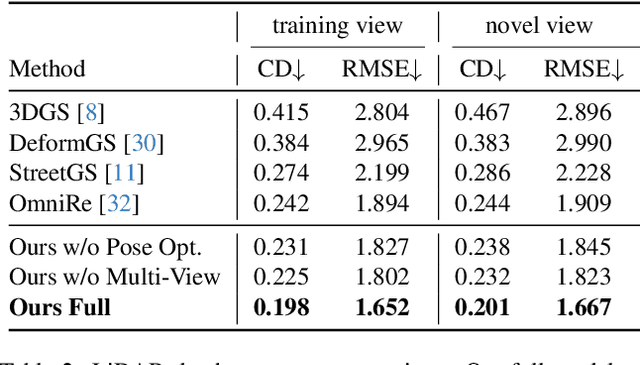
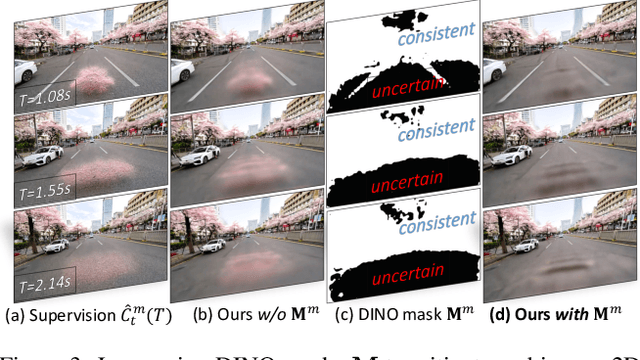
Abstract:Urban scene reconstruction requires modeling both static infrastructure and dynamic elements while supporting diverse environmental conditions. We present \textbf{StyledStreets}, a multi-style street simulator that achieves instruction-driven scene editing with guaranteed spatial and temporal consistency. Building on a state-of-the-art Gaussian Splatting framework for street scenarios enhanced by our proposed pose optimization and multi-view training, our method enables photorealistic style transfers across seasons, weather conditions, and camera setups through three key innovations: First, a hybrid embedding scheme disentangles persistent scene geometry from transient style attributes, allowing realistic environmental edits while preserving structural integrity. Second, uncertainty-aware rendering mitigates supervision noise from diffusion priors, enabling robust training across extreme style variations. Third, a unified parametric model prevents geometric drift through regularized updates, maintaining multi-view consistency across seven vehicle-mounted cameras. Our framework preserves the original scene's motion patterns and geometric relationships. Qualitative results demonstrate plausible transitions between diverse conditions (snow, sandstorm, night), while quantitative evaluations show state-of-the-art geometric accuracy under style transfers. The approach establishes new capabilities for urban simulation, with applications in autonomous vehicle testing and augmented reality systems requiring reliable environmental consistency. Codes will be publicly available upon publication.
Finetuning Generative Trajectory Model with Reinforcement Learning from Human Feedback
Mar 13, 2025



Abstract:Generating human-like and adaptive trajectories is essential for autonomous driving in dynamic environments. While generative models have shown promise in synthesizing feasible trajectories, they often fail to capture the nuanced variability of human driving styles due to dataset biases and distributional shifts. To address this, we introduce TrajHF, a human feedback-driven finetuning framework for generative trajectory models, designed to align motion planning with diverse driving preferences. TrajHF incorporates multi-conditional denoiser and reinforcement learning with human feedback to refine multi-modal trajectory generation beyond conventional imitation learning. This enables better alignment with human driving preferences while maintaining safety and feasibility constraints. TrajHF achieves PDMS of 93.95 on NavSim benchmark, significantly exceeding other methods. TrajHF sets a new paradigm for personalized and adaptable trajectory generation in autonomous driving.
Other Vehicle Trajectories Are Also Needed: A Driving World Model Unifies Ego-Other Vehicle Trajectories in Video Latant Space
Mar 12, 2025Abstract:Advanced end-to-end autonomous driving systems predict other vehicles' motions and plan ego vehicle's trajectory. The world model that can foresee the outcome of the trajectory has been used to evaluate the end-to-end autonomous driving system. However, existing world models predominantly emphasize the trajectory of the ego vehicle and leave other vehicles uncontrollable. This limitation hinders their ability to realistically simulate the interaction between the ego vehicle and the driving scenario. In addition, it remains a challenge to match multiple trajectories with each vehicle in the video to control the video generation. To address above issues, a driving \textbf{W}orld \textbf{M}odel named EOT-WM is proposed in this paper, unifying \textbf{E}go-\textbf{O}ther vehicle \textbf{T}rajectories in videos. Specifically, we first project ego and other vehicle trajectories in the BEV space into the image coordinate to match each trajectory with its corresponding vehicle in the video. Then, trajectory videos are encoded by the Spatial-Temporal Variational Auto Encoder to align with driving video latents spatially and temporally in the unified visual space. A trajectory-injected diffusion Transformer is further designed to denoise the noisy video latents for video generation with the guidance of ego-other vehicle trajectories. In addition, we propose a metric based on control latent similarity to evaluate the controllability of trajectories. Extensive experiments are conducted on the nuScenes dataset, and the proposed model outperforms the state-of-the-art method by 30\% in FID and 55\% in FVD. The model can also predict unseen driving scenes with self-produced trajectories.
UniPLV: Towards Label-Efficient Open-World 3D Scene Understanding by Regional Visual Language Supervision
Dec 24, 2024Abstract:We present UniPLV, a powerful framework that unifies point clouds, images and text in a single learning paradigm for open-world 3D scene understanding. UniPLV employs the image modal as a bridge to co-embed 3D points with pre-aligned images and text in a shared feature space without requiring carefully crafted point cloud text pairs. To accomplish multi-modal alignment, we propose two key strategies:(i) logit and feature distillation modules between images and point clouds, and (ii) a vison-point matching module is given to explicitly correct the misalignment caused by points to pixels projection. To further improve the performance of our unified framework, we adopt four task-specific losses and a two-stage training strategy. Extensive experiments show that our method outperforms the state-of-the-art methods by an average of 15.6% and 14.8% for semantic segmentation over Base-Annotated and Annotation-Free tasks, respectively. The code will be released later.
OLiDM: Object-aware LiDAR Diffusion Models for Autonomous Driving
Dec 23, 2024



Abstract:To enhance autonomous driving safety in complex scenarios, various methods have been proposed to simulate LiDAR point cloud data. Nevertheless, these methods often face challenges in producing high-quality, diverse, and controllable foreground objects. To address the needs of object-aware tasks in 3D perception, we introduce OLiDM, a novel framework capable of generating high-fidelity LiDAR data at both the object and the scene levels. OLiDM consists of two pivotal components: the Object-Scene Progressive Generation (OPG) module and the Object Semantic Alignment (OSA) module. OPG adapts to user-specific prompts to generate desired foreground objects, which are subsequently employed as conditions in scene generation, ensuring controllable outputs at both the object and scene levels. This also facilitates the association of user-defined object-level annotations with the generated LiDAR scenes. Moreover, OSA aims to rectify the misalignment between foreground objects and background scenes, enhancing the overall quality of the generated objects. The broad effectiveness of OLiDM is demonstrated across various LiDAR generation tasks, as well as in 3D perception tasks. Specifically, on the KITTI-360 dataset, OLiDM surpasses prior state-of-the-art methods such as UltraLiDAR by 17.5 in FPD. Additionally, in sparse-to-dense LiDAR completion, OLiDM achieves a significant improvement over LiDARGen, with a 57.47\% increase in semantic IoU. Moreover, OLiDM enhances the performance of mainstream 3D detectors by 2.4\% in mAP and 1.9\% in NDS, underscoring its potential in advancing object-aware 3D tasks. Code is available at: https://yanty123.github.io/OLiDM.
StreetCrafter: Street View Synthesis with Controllable Video Diffusion Models
Dec 17, 2024



Abstract:This paper aims to tackle the problem of photorealistic view synthesis from vehicle sensor data. Recent advancements in neural scene representation have achieved notable success in rendering high-quality autonomous driving scenes, but the performance significantly degrades as the viewpoint deviates from the training trajectory. To mitigate this problem, we introduce StreetCrafter, a novel controllable video diffusion model that utilizes LiDAR point cloud renderings as pixel-level conditions, which fully exploits the generative prior for novel view synthesis, while preserving precise camera control. Moreover, the utilization of pixel-level LiDAR conditions allows us to make accurate pixel-level edits to target scenes. In addition, the generative prior of StreetCrafter can be effectively incorporated into dynamic scene representations to achieve real-time rendering. Experiments on Waymo Open Dataset and PandaSet demonstrate that our model enables flexible control over viewpoint changes, enlarging the view synthesis regions for satisfying rendering, which outperforms existing methods.
 Add to Chrome
Add to Chrome Add to Firefox
Add to Firefox Add to Edge
Add to Edge